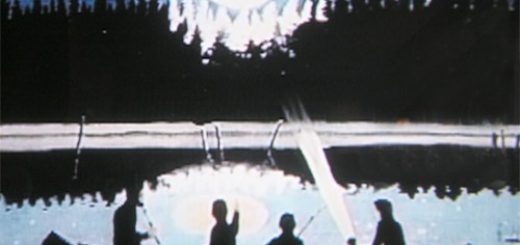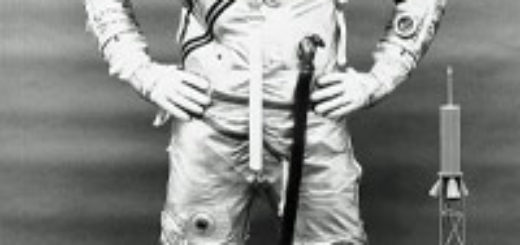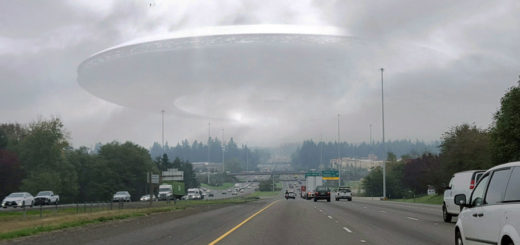Silent Flying Disks – Is This The Real Flying Saucer?
This design study for a flying saucer fighter was prepared for LOOK by Thomas Turner, a 30 year old British aeronautical engineer now employed by Republic Aviation Corp.
A Canadian saucer project that may resemble it in some details has long been rumored. Turner points out that the design could be arrived at independently and is only one of several possible approaches to the construction of a saucer craft.
Future airports built for vertically rising flying saucers would have no need of the long, vulnerable runways today’s fighters require.
The complete operation could go underground. Tunnels with take-off shafts set into the ground, complete with maintenance bays, fuel and crew quarters, would be bombproof shelters for a saucer squadron.
The shafts would be sealed after take-off for camouflage and protection.
Prone-pilot cockpit provides better streamlining than conventional seat arrangement. To bail out in an emergency, pilot releases canopy, ejects seat bed. Lack of tail structure on saucer would cut risk to a pilot during bail-out.
Close-up of one of the many jet exhaust ports around the saucers circumference shows how lift is achieved. When the lower flap is deflected, the jet blast is diverted downward
Air above the saucer then flows down with the jet stream. This reduces pressure on the top surface and the pressure difference between the upper and lower surfaces causes the saucer to rise.
Deflected jets provide additional lift.
“Saucer’s many-fingered jet pipes provide lift and directional control for craft.”
ALL TEXT EXACTLY AS FOUND IN “LOOK” ARTICLE
VOLUME 19, JUNE 14, 1955
DESPITE HUNDREDS OF “eyewitness” accounts of flying saucers, none has been captured and no government has come forward to take credit (or blame) for their reported aerial shenanigans.
So, barring the possibility that the saucers are from other planets (a theory ardently supported by science-fiction fans), it seems reasonable to conclude that “there ain’t no such animal.”
But persistent and fairly credible rumors recur that a Canadian aircraft manufacturer, A.V. Roe, Canada, Ltd., has had a saucer design under development for two years. One report has it that the project was abandoned by the Canadian government because it would cost over $75 million to get a prototype flying model into the air.
The A.V. Roe people maintain a confusing silence about the whole thing. They can’t deny the project has been abandoned because they never announced it had begun. Our own Air Force offers “no comment.”
At a recent meeting of engineers, it was indicated that, while flying saucer or sphere projects may still be purely hypothetical, new air-defense problems are setting up requirements for aircraft performance that would seem to be most ideally met by a saucer craft such as illustrated above.
One problem, recently stated by Brig. Gen. Benjamin Kelsey, deputy director of research and development of the Air Force, is this:
“Airplanes today spend too much time gathering speed on the ground and not enough flying in the air.”
Today’s fighters, he pointed out, need extremely long runways and there are few in existence that are now long enough.
These few, and the concentration of the planes using them, provide a worth-while target for an A-bomb. With a single blow, the enemy might cripple a substantial portion of our air defense.
Planes that could take off vertically would not need long runways, which cost millions of dollars. They could be dispersed widely and safely. In this country, four vertical-rising aircraft already have been revealed. All but one, however, are modifications of conventional plane designs.
None yet approaches the performance a true saucer might be capable of.
What are the requirements of an ideal defense fighter?
ability to take off and land vertically
high speed of over Mach 2. (more than 1500 mph)
high rate of climb
excellent maneuverability
heavy armament
ability to operate at 60,000 feet
These sketches indicate a highly educated guess of what a flying saucer to fulfill these requirements would look like. It provides for a one-man crew, housed in a glass bubble that would provide excellent visibility.
The prone position of the pilot not only allows improved streamlining but also enables the pilot to withstand high accelerations and quick turns.
The design contemplates use of cannon, rockets or guided missiles. Exact armament would depend on the mission. The target would be sighted by radar, and the actual firing would be computed and accomplished electronically, as in several interceptors now in operation.
Power unit is key to design. The whole success of the saucer design depends on the unusual engine. The sketched design is remarkably similar to a conventional jet engine but is many times larger. It consists of a set of combustion chambers and a large turbine. These produce blasts of propulsive air around the circumference of the saucer. Air entering the intakes around the pilots cockpit is deflected to the engine.
This pressurized air is swept up by the impeller, with a subsequent rise in pressure and temperature.
Next, the air goes to the combustion chamber, where fuel is added and ignited and a propulsive gas is formed. The hot gases rush through the turbine blades, in the process turning the impeller wheel. The gas then expands and exhausts at high velocity through the many-fingered jet pipes. The large turbine acts as a stabilizing gyroscope keeping the plane level even when it is hovering.
Design is structurally strong. The saucer shape lends itself to engineering for strength much more readily than a conventional aircraft does, with its long fuselage, thin wings and troublesome tail unit.
The simple saucer shape makes structural rigidity much less of a problem. New materials will also come into the picture.
Titanium, for example, is 60 per cent heavier than aluminum but with qualities of steel and is not as vulnerable to temperature effects as the light alloys now used in supersonic planes.
Landing problems are simple. In contrast to present vertical take-off designs, the saucer need not make a touchy stall-type landing. It is already in the correct flight attitude for landing and only the forward jets need be switched on and all jets deflected downward to provide the necessary lift to hover and land.
This description is brief and highly simplified. Military security and rapidly changing defense problems not only cloud many details of a project like this but also obscure whether anything comparable actually exists.
But based on the current requirements of our defense effort and the demonstrated abilities of our designers, an educated guess is that a flying saucer much like this one may well be flying within the next few years.



 Creators of mankind
Creators of mankind Description of “Tall white aliens”
Description of “Tall white aliens” Where they came from?
Where they came from? About hostile civilizations
About hostile civilizations The war for the Earth
The war for the Earth “Tall white aliens” about eternal life
“Tall white aliens” about eternal life Video: “Nordic aliens”
Video: “Nordic aliens” Aliens
Aliens Alien encounters
Alien encounters The aliens base
The aliens base UFO
UFO Technology UFO
Technology UFO Underground civilization
Underground civilization Ancient alien artifacts
Ancient alien artifacts Military and UFO
Military and UFO Mysteries and hypotheses
Mysteries and hypotheses Scientific facts
Scientific facts


















